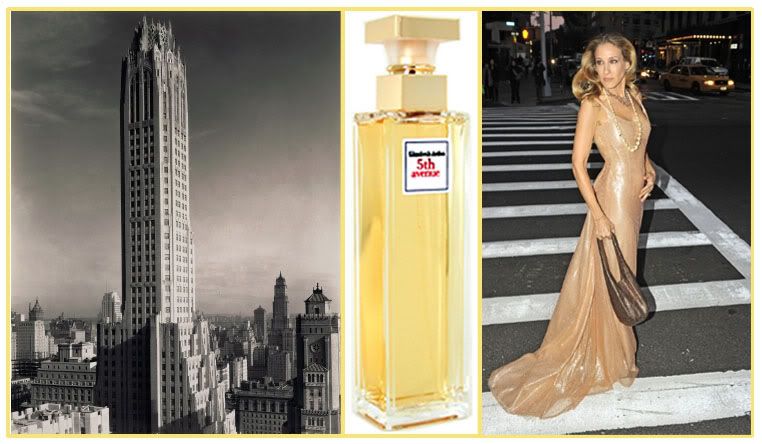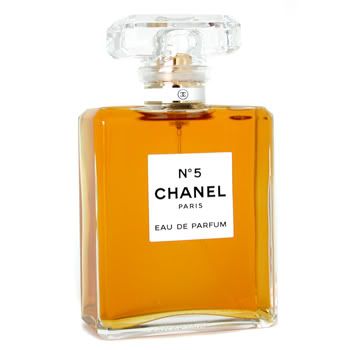 |
(The image is #6 in the linked slide show)
Center: 5th Avenue by Elizabeth Arden
Right: Sarah Jessica Parker in a Halston Heritage gown in front of
Lincoln Center
5th Avenue's notes are:
Top notes: Lilac, linden blossom, dewy magnolia, mandarin and bergamot
Middle notes: Bulgarian pink violet, ylang-ylang, jasmine, Indian tuberose, peach, carnation and nutmeg
Base notes: Amber, Tibetan musk, sandalwood, iris and vanilla
------------------------------------------------------------------------------------
Elizabeth Arden's perfume 5th Avenue was outrageously marked down to a mere $12 (Canadian) during the holiday season. Whoever heard of a classic perfume selling for pennies? Nina Ricci's perennially popular L'Air du Temps was also packaged for less than fifty dollars. Part of the problem is that perfume houses are being out-sourced, so to speak, to celebrity fragrances (I hate to call them perfumes). Halle Berry, Britney Spears, Jennifer Lopez, and many more, have taken on the lofty position of the arbitrators of our scents. And not with much success, after the initial euphoria (exhibited mostly by adolescent fans).
I've written about the complicated task of choosing scents in my blog post "Chanel's Concoctions." In Chanel's Art Deco era, perfume was associated with high art, not the pop art we have now. Classical musicians and composers, painters and sculptors, all contributed to the "lesser" arts of fashion and home decor. Shalimar's perfume, which was exhibited at the famous Paris International Exposition of Modern Industrial and Decorative Arts in 1925, was a small masterpiece combining the senses and the arts (I argue this in "Shalimar: Senses in a Bottle"). Chanel, although not in the exhibition, was part of this Art Deco movement.
The contemporary stars Jennifer Lopez and Britney Spears have not only produced mediocre scents, their bottles are also inferior. Britney's foray into bottle design consists of crudely aligned "gemstones" and Jennifer Lopez's bottle looks like Dior's J'Adore knock-off. J'Adore came out in 1999, and Glow was on the market in 2003.
Coty is behind J'Adore's bottle design and Lopez's Glow perfume, so I wasn't so far off in the "associations" I saw between Glow and J'Adore. Shame on Coty, which has a long history of working with perfume bottle giants like Lalique, and creates fragrances for discerning clients! Still, design and art in some respects never lie. What Coty gave Lopez is mediocrity, a mere imitation, perhaps commenting on the product as a whole. Lopez is an aggressive (Latina) celebrity, and Coty may have found it difficult to refuse her patronage.
In my modest survey of current celebrity perfumes and fashion promoters, Sarah Jessica Parker is the winner. And as I've written here about her perfume Lovely, even her bottle design is attractive, true to the memory of the vanguard perfume creators of the past.
Lovely's bottle is gently-rounded, like a water/perfume droplet. The pale pink bottle is complemented with a light gray ribbon around the neck. The only fault I find with Lovely, both in scent and design, is that it doesn't have a the "presence" of Shalimar, or much of a concept other than prettiness.
Sarah Jessica Parker is still quite a step above pop star designers like Jennifer Lopez and Britney Spears. She is now the Chief Creative Officer at Halston, a respectable, classic fashion house. Perhaps she will start her own clothing line, following in the footsteps of such untiring creators of the past as Chanel.
5th Avenue, on the other hand, does have a presence. It's bottle delicately conjures the sleek, elongated structures of New York City's sky scrapers. I tried to find a building that might fit its structure, and while looking at turn-of-the-century photographs of New York by Alfred Stieglitz, I came up with the RCA tower posted above.
Even 5th Avenue's scent is a whirlwind of florals; eleven according to the perfume website Fragrantica, which are interspersed in all three of its notes. It is, like the sky scraper, an ambitious idea.
 |
5th Avenue is clearly a reference to Chanel No. 5. The symmetrical, unadorned, modernist bottle from Chanel No. 5 has been elongated into the 5th Avenue flask. The bottle stoppers are also very similar. Chanel named her perfume after the laboratory vial labeled No. 5, which contained the scent that she chose for her perfume.
The five in 5th Avenue is also a systematic way of labeling, this time the long streets in New York City. 5th Avenue is where Arden opened her first store independently. It is also the center of fashion in the fashion center, New York City. It is thus an apt name for a perfume that references a famous fashion predecessor.
Yet despite the restraint in the bottles' adornments, and even names, the scents of both Chanel No. 5 and 5th Avenue are complex and unrestrained. 5th Avenue, on a conservative count, has seventeen ingredients (listed above). The original No. 5 had 31 ingredients.
Although it is a shame that classic perfumes like 5th Avenue have to marked down to such give-away prices, it suits me fine! It is hard to commit to an expensive perfume. And especially these days, marked down classics are one way to discover new (old) fragrances. It is a clever marketing tactic. Classics may wane, but they will never disappear.
Posts on perfumes at Camera Lucida:
- Lovely
- Perfume Experts, Online
- Lalique and Chanel: A Natural Partnership
- Reliving the 1920s through Perfume
- Chanel's Concoctions
- Shalimar: Senses in a Bottle